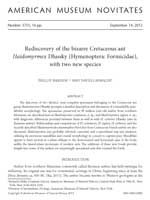The discovery of two distinct, near-complete specimens belonging to the Cretaceous ant genus Haidomyrmex Dlussky prompts a detailed description and discussion of a remarkable mandibular morphology. The specimens, preserved in 98 million-year-old amber from northern Myanmar, are described here as Haidomyrmex scimitarus, n. sp., and Haidomyrmex zigrasi, n. sp., with diagnostic differences provided between them as well as with H. cerberus Dlussky (also in Burmese amber). Relationships and comparisons of H. scimitarus, H. zigrasi, H. cerberus, and the recently described Haidomyrmodes mammuthus Perrichot from Cretaceous French amber are also discussed. Haidomyrmex was probably arboreal, cursorial, and a specialized trap-jaw predator, utilizing its enormous mandibles and cranial morphology in concert to capture prey. Mandibles appear to have moved in a plane oblique to the dorsoventral and horizontal axes of the body, unlike the lateral-plane movement of modern ants. The additions of these new fossils provide insight into some of the earliest yet surprisingly specialized ants that roamed the Earth.
How to translate text using browser tools
14 September 2012
Rediscovery of the Bizarre Cretaceous Ant Haidomyrmex Dlussky (Hymenoptera: Formicidae), with Two New Species
Phillip Barden,
David Grimaldi





